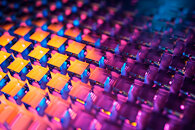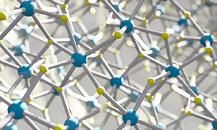T0@st
News Editor
- Joined
- Mar 7, 2023
- Messages
- 3,113 (3.92/day)
- Location
- South East, UK
| System Name | The TPU Typewriter |
|---|---|
| Processor | AMD Ryzen 5 5600 (non-X) |
| Motherboard | GIGABYTE B550M DS3H Micro ATX |
| Cooling | DeepCool AS500 |
| Memory | Kingston Fury Renegade RGB 32 GB (2 x 16 GB) DDR4-3600 CL16 |
| Video Card(s) | PowerColor Radeon RX 7800 XT 16 GB Hellhound OC |
| Storage | Samsung 980 Pro 1 TB M.2-2280 PCIe 4.0 X4 NVME SSD |
| Display(s) | Lenovo Legion Y27q-20 27" QHD IPS monitor |
| Case | GameMax Spark M-ATX (re-badged Jonsbo D30) |
| Audio Device(s) | FiiO K7 Desktop DAC/Amp + Philips Fidelio X3 headphones, or ARTTI T10 Planar IEMs |
| Power Supply | ADATA XPG CORE Reactor 650 W 80+ Gold ATX |
| Mouse | Roccat Kone Pro Air |
| Keyboard | Cooler Master MasterKeys Pro L |
| Software | Windows 10 64-bit Home Edition |
Scientists and engineers have been experimenting with hafnium oxide over the past decade—many believe that this "elusive ferroelectric material" is best leveraged in next generation computing memory (due to its non-volatile properties), although this requires a major scientific breakthrough to get working in a practical manner. Hafnia's natural state is inherently non-ferroelectric, so it takes some effort to get it into a suitable state—a SciTechDaily article explores past efforts: "Scientists could only get hafnia to its metastable ferroelectric state when straining it as a thin, two-dimensional film of nanometer thickness." Research teams at the University of Rochester, New York and University of Tennessee, Knoxville have presented evidence of an exciting landmark development. Sobhit Singh, assistant professor at UoR's Department of Mechanical Engineering, believes that the joint effort has created a lane for the creation of bulk ferroelectric and antiferroelectric hafnia.
His "Proceedings of the National Academy of Sciences" study proposes an alternative material path: "Hafnia is a very exciting material because of its practical applications in computer technology, especially for data storage. Currently, to store data we use magnetic forms of memory that are slow, require a lot of energy to operate, and are not very efficient. Ferroelectric forms of memory are robust, ultra-fast, cheaper to produce, and more energy-efficient." Professor Janice Musfeldt's team at the University of Tennessee have managed to produce a ferroelectric form of hafnia—through an experimental high pressure process, based on Singh's exact calculations. The material remained in a metastable phase post-experiment, even in a pressure-relieved state. Musfeldt commented on the pleasing results: "This is as an excellent example of experimental-theoretical collaboration." Memory manufacturers are likely keeping an eye on Hafnia's breakthrough potential, but material costs are dampening expectations—Tom's Hardware cites shortages (going back to early 2023): "Hafnium (the key component in Hafnia) has seen a nearly fivefold price increase due to increased demand since 2021, raising its cost from about $1,000 per kilogram to about $5,000. Even at $1000 a kilogram, though, hafnium is by far more expensive than silicon, which measures in the tens of dollars per kilogram."



View at TechPowerUp Main Site | Source
His "Proceedings of the National Academy of Sciences" study proposes an alternative material path: "Hafnia is a very exciting material because of its practical applications in computer technology, especially for data storage. Currently, to store data we use magnetic forms of memory that are slow, require a lot of energy to operate, and are not very efficient. Ferroelectric forms of memory are robust, ultra-fast, cheaper to produce, and more energy-efficient." Professor Janice Musfeldt's team at the University of Tennessee have managed to produce a ferroelectric form of hafnia—through an experimental high pressure process, based on Singh's exact calculations. The material remained in a metastable phase post-experiment, even in a pressure-relieved state. Musfeldt commented on the pleasing results: "This is as an excellent example of experimental-theoretical collaboration." Memory manufacturers are likely keeping an eye on Hafnia's breakthrough potential, but material costs are dampening expectations—Tom's Hardware cites shortages (going back to early 2023): "Hafnium (the key component in Hafnia) has seen a nearly fivefold price increase due to increased demand since 2021, raising its cost from about $1,000 per kilogram to about $5,000. Even at $1000 a kilogram, though, hafnium is by far more expensive than silicon, which measures in the tens of dollars per kilogram."



View at TechPowerUp Main Site | Source


